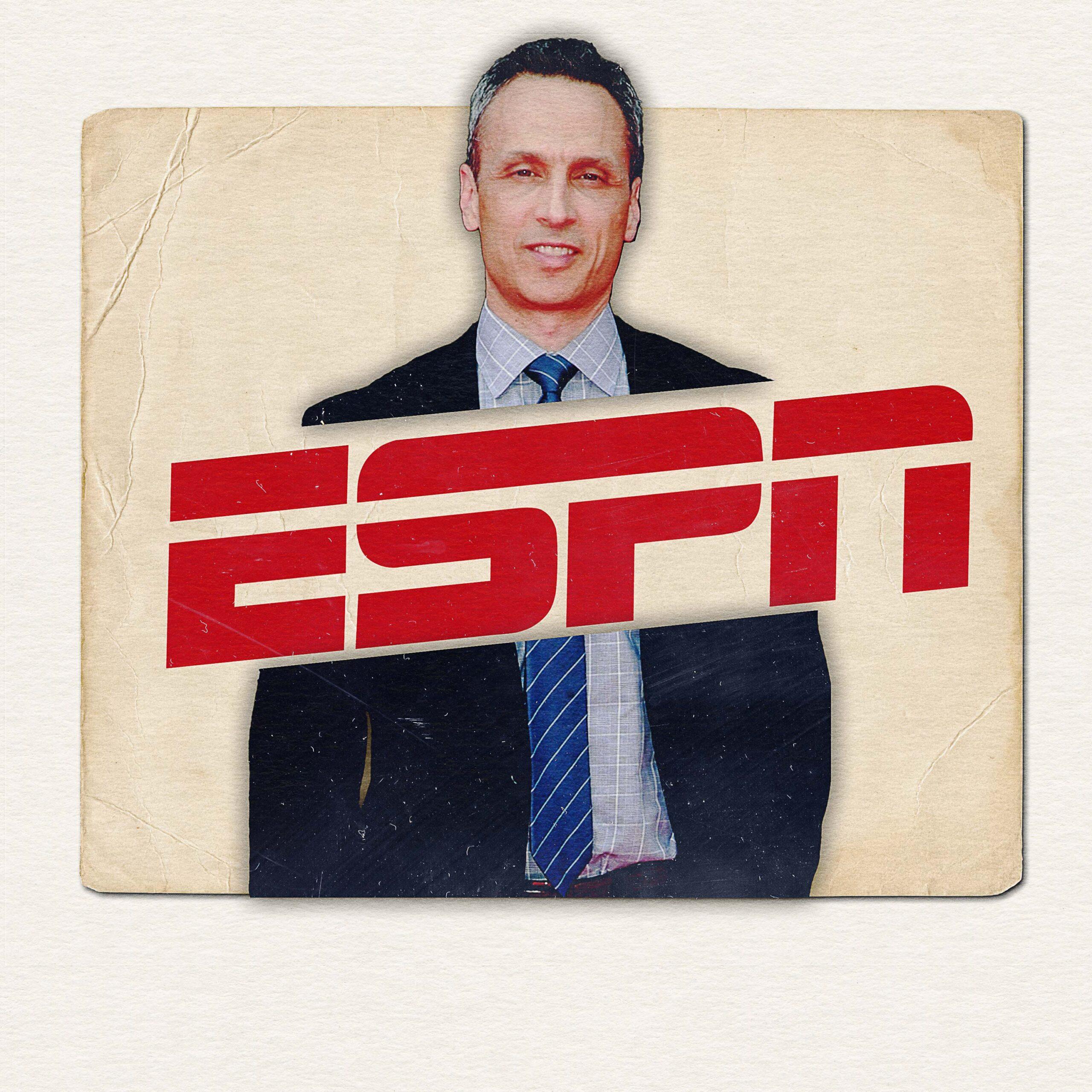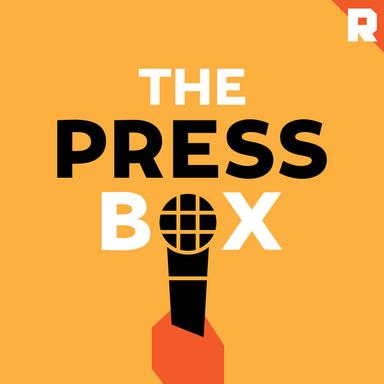
There have been moments during the reign of ESPN chairman Jimmy Pitaro—the release of Zach Lowe, say, or the cancellation of Around the Horn—when people asked, What was Jimmy thinking? Today, your phone can tell you the answer. Pitaro was thinking about the ESPN app.
The rebooted app is ESPN’s future. For the first time, you can access everything the company has to offer for $29.99 a month. You can pay ESPN directly without paying a third party like a cable outfit or YouTube TV. Pitaro wants the app to help him carry ESPN across the suspension bridge between the Cable Mountain and Streaming Plateau.
The success of Pitaro’s app won’t be known for a while. In the short term, ESPN doesn’t expect a majority of viewers to buy direct. ESPN would be happy if its cable and YouTube TV customers use the app, so ESPN can learn about them.
What’s clear is that Pitaro’s monomania about the future—his vow to keep his eye on the ball—has transformed ESPN in profound ways. It’s worth saying how, exactly.
In 2018, when Pitaro took over ESPN, he had a mandate to think about the future. It wasn’t just that the cable bundle was crumbling. ESPN was a mess. A Barstool show was torpedoed by staff. There was a fantasy football auction that resembled a human auction. Pitaro’s predecessor, John Skipper, by his own later admission, had been using cocaine.
The first way Pitaro changed the shape of ESPN was by buying live events. Lots of them. Big ones. He bought better NFL games, more NFL games, a Super Bowl, the NBA Finals, WrestleMania, the full SEC schedule, and the College Football Playoff. ESPN has never had a better collection of games in its history.
In a different moment in media time, the sports ESPN showed were less interesting than the things its announcers said about sports. If Pitaro’s predecessors began the process of reversing that ratio, Pitaro has completed it. You could argue he had to, since games are some of the only programming anyone wants to watch live in the streaming age.
Pitaro’s approach to ESPN’s talent was also shaped by the times. Disney would have directed anybody running ESPN to trim the company’s staff. Two years ago, Pitaro presided over layoffs that cast off Jeff Van Gundy and others.
What’s interesting is how the discourse around ESPN’s talent changed under Pitaro’s leadership. Professional media critics used to spend lots of time talking about ESPN talent: their ambitions, their hopes, their dreams. With the notable exceptions of Pat McAfee and Stephen A. Smith, when’s the last time we had a national conversation about an ESPN announcer’s feelings?
If Pitaro’s approach to talent was dictated by media contraction, you could argue his negotiations with talent were helped by the same forces. An announcer wanting to leave ESPN, or find a competing bid elsewhere to gain some leverage in Bristol, has very few places to turn. Now, a lot of negotiations go like Ryan Clark’s did last year. He released a Twitter video about getting paid what he was worth. A few days later, he agreed to a new ESPN deal. And, as a society, we moved along.
Pitaro’s only deviation from this approach came when he spent big money for high-end announcers, his new A-Team. He made deals with Joe Buck and Troy Aikman for Monday Night Football, with the Manning brothers, with Smith and McAfee, with the Inside the NBA crew. These were signings designed to fill scheduling holes or solve problems. (Between Joe and Troy and the Mannings, you could argue Pitaro solved the Monday Night Football problem twice.)
One morning last week, I met Pitaro in his Bristol office. He was wearing a striped Masters golf shirt and had stubble on his chin. I asked him: Do you ever worry you’re shopping at the top of the market instead of developing talent?
In interviews, Pitaro is reluctant to commit to a single strategy. Pitaro told me ESPN was both hiring and developing, citing Malika Andrews as an example of the latter.
It’s true that Pitaro’s lieutenants made Andrews, who joined the company a few months after the chairman, the host of ESPN’s NBA studio show. The same lieutenants also failed to develop a show around Andrews that could compete with Inside the NBA. Then ESPN bought Inside the NBA.
To that end, I asked Pitaro if he worried ESPN was buying shows (Inside, the Manningcast, McAfee) rather than developing them? Without sounding too much like a midterm political ad, it feels like a network loses something important if it forgets how to manufacture products itself.
Again, Pitaro insisted ESPN was both buying and developing. Yet other than Get Up and a renovated College GameDay with McAfee and Nick Saban, it’s hard to think of great shows that have been developed in-house during his tenure. A hallmark of Pitaro’s ESPN is that the company employs Mina Kimes to cover the NFL—hooray—but contracts with Omaha to produce her podcast.
This explains part of the way ESPN changed. Under Pitaro, the company has begun to think less like a network built around a particular sensibility and more like a sports-adjacent ark that can accommodate just about anyone (Stephen A., John Cena, influencer Katie Feeney), provided—of course—they put butts in the seats. Another way of saying this is that ESPN under Pitaro has begun to think like an app. Like Netflix or Amazon Prime, ESPN finds someone they want to do business with. They make a deal. That person becomes ESPN.
That kind of thinking is much better suited to the times than hiring SportsCenter anchors or, god forbid, journalists. To survive in the streaming world, ESPN probably needs to overwhelm viewers with great games and different voices rather than develop a particular aesthetic.
But as a consumer, rather than a business analyst, this change has made it harder to figure out what ESPN stands for. Sometimes, it’s easier to figure out what it doesn’t stand for.
After arriving at ESPN during the first Trump administration, Pitaro set about cleansing ESPN of most of its political commentary. Employees stopped tweeting about Trump, mostly. Last week, Pitaro told me the process had been completed to his satisfaction. Though with this month’s NFL Network deal needing the approval of the Trump administration, ESPN employees have a chance to do the funniest thing…
Pitaro’s reconciliation process with the NFL had a similar vibe. ESPN was not in the business of getting sideways with America’s pastime, as Skipper did. Burke Magnus, Pitaro’s no. 2, called ESPN’s fence-mending project a “reset.” The reset was completed when ESPN bought the NFL Network and other assets in exchange for giving the league a 10 percent equity stake.
The deal, alongside another that Pitaro made with WWE, was announced the week before I arrived in Pitaro’s office. He assured me that he told the NFL that ESPN’s journalistic arms would continue to function, despite the league’s part-ownership. Last week, Roger Goodell dropped into an ESPN town hall meeting to make the same point.
I doubt Pitaro will get caught in a public standoff with one of his own journalists. His ESPN is not about that, either. Let’s say Don Van Natta Jr. breaks a story that annoys the NFL, as he is wont to do. I bet the story will run. It’s also true that the new ESPN has fewer vehicles to promote such a story: no daily Outside the Lines TV show; a website devoted to takes delivered on TV. There’s a difference between doing something and hawking it.
ESPN’s handling of McAfee’s comments about Ole Miss student Mary Kate Cornett was also instructive. In February, McAfee repeated a false, repugnant social media rumor about Cornett. Then, nothing happened … for months. In April, when the Barstool guys were looking into their phones to apologize to Cornett, the network was silent. Finally, nearly five months after his comments, McAfee apologized, saying he’d been waiting to meet with Cornett’s family first.
Last week, when I asked Pitaro about this, he told me he was pleased with McAfee’s apology. He repeated the host’s explanation about meeting with Cornett’s parents. “They were satisfied,” he said. “Pat was satisfied. I was happy with Pat’s on-air apology. And we move on.”
What about ESPN’s viewers? I asked. If Cornett’s family was owed an explanation and an apology, surely viewers were, too. “We talked about that internally,” said Pitaro, before repeating he was “at peace” with McAfee’s approach.
It’s hard to square the bravado about NFL reporting with a five-month lag between an error and a correction. But if there’s something else Pitaro’s ESPN is not about, it’s a public fight with an anchor, a suspension, corporate business being transacted in front of the public. In our conversation, Pitaro kept his eye on the ball. There were many great games to be shown on the app. There was a company to nudge into the streaming age. And we move on.



